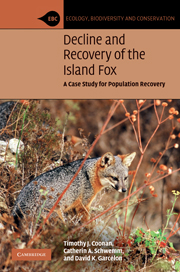Book contents
- Frontmatter
- Contents
- Foreword
- Acknowledgments
- 1 Introduction
- 2 Evolution and genetics
- 3 Social structure, reproduction, mortality and survivorship, and population dynamics
- 4 Food habits, habitat use, activity patterns, and dispersal
- 5 Golden eagles and the decline on the northern islands
- 6 Ecosystem recovery
- 7 Disease and decline on Santa Catalina Island
- 8 Recovery actions
- 9 Recovery actions
- 10 Reproductive biology, by Cheryl Asa
- 11 Diseases of island foxes, by Linda Munson
- 12 Zoos, education, and public participation
- 13 Managing recovery
- 14 The ecological role of island foxes
- 15 Conclusion
- References
- Index
10 - Reproductive biology, by Cheryl Asa
Published online by Cambridge University Press: 05 October 2010
- Frontmatter
- Contents
- Foreword
- Acknowledgments
- 1 Introduction
- 2 Evolution and genetics
- 3 Social structure, reproduction, mortality and survivorship, and population dynamics
- 4 Food habits, habitat use, activity patterns, and dispersal
- 5 Golden eagles and the decline on the northern islands
- 6 Ecosystem recovery
- 7 Disease and decline on Santa Catalina Island
- 8 Recovery actions
- 9 Recovery actions
- 10 Reproductive biology, by Cheryl Asa
- 11 Diseases of island foxes, by Linda Munson
- 12 Zoos, education, and public participation
- 13 Managing recovery
- 14 The ecological role of island foxes
- 15 Conclusion
- References
- Index
Summary
An increasing number of endangered species, including several canids, have depended on captive breeding programs as critical components in their recovery. Red wolves (Canis rufus) and Mexican gray wolves (Canis lupus baileyi), for example, became extinct in the wild and existed only in zoos before being reintroduced as wild populations. Despite considerable experience in North American zoos with some canids, each new species brings new challenges. Prior to the recovery effort that began in 1999, island foxes had never before been kept in captivity for breeding purposes. And although their mainland cousin, the gray fox (Urocyon cinereoargenteus), was historically held in small numbers in some zoos, they had never been the focus of a breeding program, so little information existed on their husbandry and breeding requirements. In addition, when establishing a breeding program, knowledge of a species' mating system and reproductive biology can be keys to success. As captive breeding for recovery tool of island foxes began, very little information on reproduction was available, even though recovery might hinge on a successful captive breeding program.
One initial approach when faced with such a challenge is to draw from information about closely related, more common species. In the case of the island fox, the obvious comparison is to the mainland gray fox. With a broad range extending from southern Canada into the northern countries of South America, the gray fox has certainly been studied more than the island fox.
- Type
- Chapter
- Information
- Decline and Recovery of the Island FoxA Case Study for Population Recovery, pp. 115 - 128Publisher: Cambridge University PressPrint publication year: 2010



